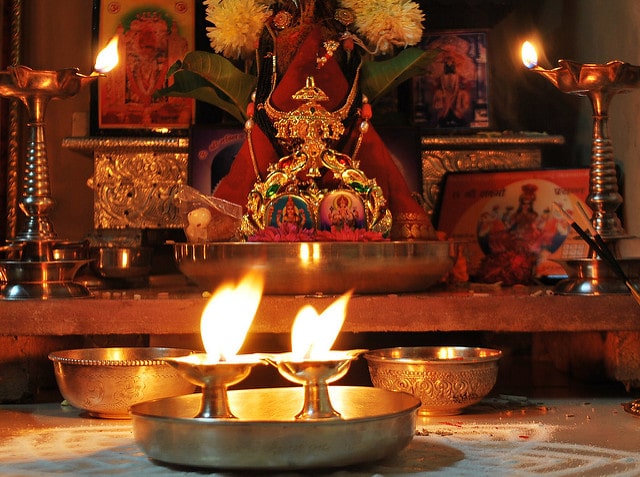12 Powerful Pujas in India That Bring Positivity and Blessings
India, known as the land of devotion and spirituality, has a rich tradition of Pujas—rituals and ceremonies performed to honor deities, seek blessings, and foster spiritual growth. Pujas are more than rituals; they are a bridge between humans and divine energies. This article explores the history, facts, timeline, significance, FAQs, impact on daily life, and societal importance of Pujas, written in a human-friendly and inspirational tone.
History of Pujas
Vedic Origins (1500–500 BCE): Pujas originated in the Vedic period, where rituals were performed for divine blessings, prosperity, and protection.
Epic Era: In texts like Ramayana and Mahabharata, Pujas were performed by kings, sages, and devotees to invoke the blessings of gods and goddesses.
Classical Period: Temples became centers of elaborate Pujas, rituals were codified, and devotional practices flourished.
Medieval Era: Saints and spiritual leaders promoted Pujas to strengthen devotion and community engagement.
Modern Era: Pujas are performed in homes, temples, and ashrams, adapting ancient rituals to contemporary lifestyles.
Interesting Facts About Pujas
Meaning of Puja: The word “Puja” comes from Sanskrit, meaning reverence or worship.
Types of Pujas:
Daily Puja: Simple daily worship at home.
Festival Puja: Performed during Navaratri, Diwali, Ganesh Chaturthi, and other festivals.
Special Pujas: Includes Lakshmi Puja, Durga Puja, Shiva Puja, and Satyanarayan Puja for specific blessings.
Elements of Puja: Includes offerings, flowers, incense, mantras, and prayers.
Spiritual Benefits: Pujas purify the mind, promote positivity, and strengthen faith.
Cultural Significance: Pujas preserve rituals, traditions, and religious texts.
Community Bonding: Festival Pujas bring families and communities together.
Healing Aspect: The rituals and chanting can reduce stress and bring mental calmness.
Global Reach: Pujas are performed by the Indian diaspora worldwide, maintaining spiritual and cultural roots.
Guidance from Gurus: Many Pujas require ritualistic precision and guidance from priests or spiritual leaders.
Modern Adaptation: Today, online resources and virtual Pujas make it accessible for people globally.
Timeline of Pujas in India
Vedic Period (1500–500 BCE): Rituals and homas (fire ceremonies) were the earliest forms of Puja.
Epic Period (500 BCE–500 CE): Pujas were documented in Ramayana and Mahabharata.
Classical Period (500–1500 CE): Temple-based rituals and structured Pujas evolved.
Medieval Period (1500–1800 CE): Saints promoted devotional Pujas across communities.
Modern Era (1800–Present): Pujas are practiced at homes, temples, and globally with modern adaptations.
Significance of Pujas
Spiritual Significance: Pujas invoke divine presence, enhance devotion, and align energies.
Mental and Emotional Benefits: Chanting and rituals promote peace, reduce stress, and encourage positive thinking.
Cultural Preservation: Pujas preserve ancient traditions, Sanskrit, and religious texts.
Daily Life Impact: Regular Pujas foster mindfulness, gratitude, and moral values.
Societal Importance: Community Pujas strengthen social cohesion, collective spirituality, and cultural identity.
FAQs About Pujas
Q1: What is a Puja?
A1: A Puja is a ceremonial act of worship involving offerings, prayers, and rituals to honor deities.
Q2: Can anyone perform a Puja?
A2: Yes, Pujas can be performed by anyone, though priest guidance is recommended for complex rituals.
Q3: How often should one perform a Puja?
A3: Daily simple Pujas are recommended; special Pujas during festivals or for specific blessings are also common.
Q4: Are Pujas only Hindu rituals?
A4: While rooted in Hinduism, similar forms of worship exist in Jainism, Buddhism, and other Indian spiritual traditions.
Q5: What are the benefits of performing a Puja?
A5: Promotes spiritual growth, emotional balance, mental clarity, and societal harmony.
Impact on Daily Life
Spiritual Growth: Encourages devotion, mindfulness, and inner peace.
Positive Energy: Rituals and chanting create a positive atmosphere in homes and communities.
Ethical Living: Teaches gratitude, discipline, and respect for traditions.
Mental Wellness: Reduces stress, anxiety, and negativity.
Community Bonding: Brings people together during festivals and religious ceremonies.
Observance and Wishing
Daily Practice: Light lamps, offer flowers, and chant simple mantras.
Festivals: Participate in Durga Puja, Ganesh Chaturthi, Lakshmi Puja, and other festival rituals.
Special Intentions: Perform Pujas for health, wealth, success, and protection.
Guidance: Consult priests or gurus for traditional or complex Pujas.
Conclusion: Why Pujas Matter
Pujas are timeless spiritual practices that connect humans with the divine, promote mental peace, and preserve cultural heritage. In daily life, they instill discipline, gratitude, and positivity, while at the societal level, they strengthen community bonds and cultural identity. Regular observance of Pujas can truly transform personal and collective life, bringing blessings, harmony, and spiritual growth.
Quick Recap: 12 Powerful Facts About Pujas
Connect individuals with divine energies.
Originated in Vedic rituals.
Prominent in Epics and Puranas.
Include daily, festival, and special Pujas.
Promote mental and emotional balance.
Preserve culture and traditions.
Enhance positive energy at home and society.
Reduce stress and encourage mindfulness.
Strengthen community and social cohesion.
Teach gratitude, devotion, and moral values.
Accessible globally through modern adaptations.
Transform life spiritually, mentally, and emotionally.
Pujas
Usually Hindus pray once or twice in a day. There are many different types of pujas for inaugurations, marriages, birthdays etc. in the Hindu religion. Puja is generally observed after a shower. And it is recommended that rituals should be performed before eating to make sure sattvic (holy) qualities and concentration (dhyana) of the devotee.
The Idol Worship – Murti Puja
The image, icon or any other symbol of the god during puja becomes the means of gaining access to the almighty. Although, the idol is not the god itself but it is considered to be filled with the god’s celestial powers. The idols are created as containers for spiritual power that make the devotee to experience the direct communication with the god.
The idol acts as a medium to respect and honour, the god. Idol Worship doesn’t stand for blind faith but it shows the feelings of a devotee towards the god. The beautiful images of the divine which are always observed show that people consider God in the ultimate manner. The images serve as visual metaphors to express the invisible divine reality. This section covers the following puja:
Budha Puja
Budha Puja or Mercury Puja is dedicated to planet Mercury. Budha Puja on Wednesdays brings in manifold benefits like eliminating difficulties, healthy progeny, possession of fertile lands etc. Following things are associated with Buddha- the Mercury:
Chandra Puja
Chandra Puja is dedicated to Lord Chandra, the Moon God. Grah Shanti Chandra Puja (Moon Worship) is recommended to those, having malefic Chandra or wrongly placed moon as per the horoscope. The following list includes couple of things associated with Chandra.
Guru Puja
Guru or Brihaspati Puja is dedicated to planet Jupiter. Grah Shanti Guru Pooja (Worship of Jupiter) is recommended to those, having malefic guru or wrongly placed Jupiter as per the horoscope. Here is list comprising a couple of things associated with Guru / Brihaspati.
Hanuman Puja
Hanuman Pooja is really beneficial for all those who want to attain strength, wisdom and knowledge. The worship of Shri Hanuman ji, the monkey God cures all illness and gives courage to fight the illness. Hanuman Puja provides peace of mind as well. Following things are required for Hanuman Puja.
How to do Puja
Puja is a sacred practice of reverence, honor, adoration or worship from the devotee towards the Almighty. Puja could mean different things to different people. For Puja, all you need to have is a devoted heart full of love for the divine. The merciful God overlooks the shortcomings of men if they follow the path of spirituality with devotion.
Kali Puja
Kali Puja is a passionate prayer to the fearsome, ferocious goddess. The aim of Kali Puja is to seek the help of Maa Kali in destroying evil, both in the outside world and within us. It is believed that Kali Puja is performed to diminish ego and all negative tendencies that hamper spiritual growth.
Ketu Puja
Ketu (Dragon’s Tail) Puja is dedicated to planet Ketu. Grah Shanti Ketu Pooja (Worship of Dragon’s Tail) is recommended for those, having malefic Ketu or wrongly placed Ketu as per the horoscope. Following things are associated with Ketu (dragon’s tail):
Mangal Puja
Mangal Puja or Mars Worship is dedicated to planet Mars. Grah Shanti Mangal Pooja liberates one from debts, poverty and skin problems. Here is a list of things associated with Mangal (Mars).
Rahu Puja
Rahu Puja or the Dragon’s Head Worship is dedicated to planet Rahu. Grah Shanti Rahu Pooja is recommended for those, having malefic Rahu or wrongly placed Rahu as per the horoscope.
Satyanarayan Puja
Satyanarayan Puja can be performed on any day. However, Purnima (Full Moon Night) and Sakranti are considered as the most auspicious days for Satyanarayan Pooja. The appropriate time of Puja is regarded in the evening but prayers in the morning will also work.
Shani Puja
Shani Puja is done to appease planet Saturn. Grah Shanti Shani Pooja (Worship of Saturn) is sought for mental peace and to get rid of various diseases. Following things are associated with Shani (Saturn).
Shukra Puja
Shukra (Venus) Puja is done to appease planet Venus. Grah Shanti Shukra Pooja is recommended to those, having malefic shukra or wrongly placed Venus as per the horoscope.
Surya Puja
Surya Puja or Sun Worship is dedicated to Lord Surya. Grah Shanti Surya Puja or Sun worship is recommended to those, having malefic surya or wrongly placed sun as per the horoscope.
Tulsi Puja
Tulsi is a sacred plant which can be found in almost every Hindu’s home. Tulsi Pooja (Worship of Tulsi) is observed almost every day. Following things are required for Tulsi Puja.








